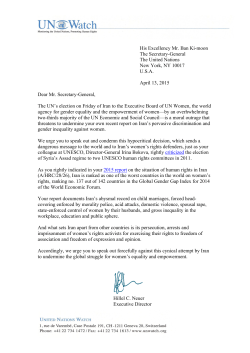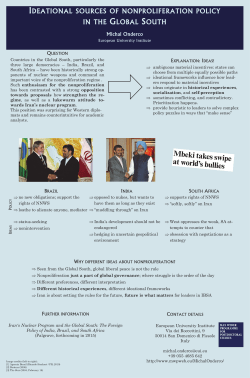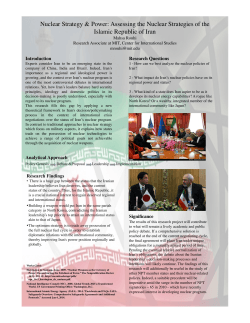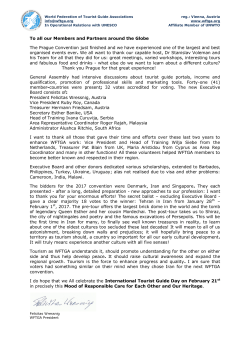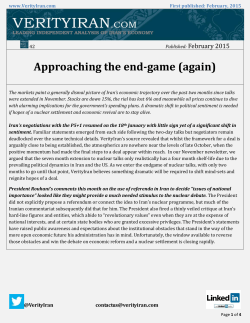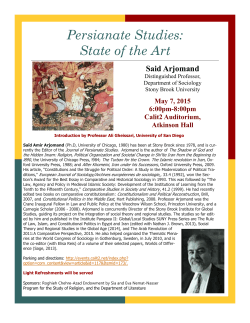
a nuclear deal with iran: prospects and challenges
NUCLEAR D AN: PROSP ALLENGES A NUCLEAR DEAL WITH IRAN: PROSPECTS AND CHALLENGES Dr. Bruno Tertrais March 2015 A NUCLEAR DEAL WITH IRAN: PROSPECTS AND CHALLENGES ABOUT EFD The European Foundation for Democracy is a Brussels-based policy institute dedicated to upholding Europe’s fundamental values of freedom and equality, regardless of gender, ethnicity or religion. Today these principles are being challenged by a number of factors, among them rapid social change as a result of high levels of immigration from cultures with different customs, a rise in intolerance on all sides, an increasing sense of a conflict of civilisations and the growing influence of radical, extremist ideologies worldwide. We work with grassroots activists, media, policy experts and government officials throughout Europe to identify constructive approaches to addressing these challenges. Our goal is to ensure that the universal values of the Enlightenment – religious tolerance, political pluralism, individual liberty and government by democracy – remain the core foundation of Europe’s prosperity and welfare, and the basis on which diverse cultures and opinions can interact peacefully. ABOUT THE AUTHOR Dr. Bruno Tertrais is Senior Research Fellow at the Foundation for Strategic Research (FRS). He specialises in international security issues including geopolitics; transatlantic relations; and European, Middle Eastern and Asian security, military and nuclear issues. He was a member of the two French presidential task forces that worked on the White Papers on Defence and National Security of 2007 and 2013. Before joining FRS, Dr Tertrais worked at the French Ministry of Defence (1993–2001), for the RAND Corporation (1995–6) and at the NATO Parliamentary Assembly (1989–93) EXECUTIVE SUMMARY A nuclear deal with Iran could not be achieved in November 2014, because the positions of the two sides remained too far apart on key issues for a global compromise to be crafted. However, this was not due to the negotiators’ lack of will or creativity. The main reason is almost certainly that Iran’s leadership does not believe that it needs to make painful concessions. It wants to alleviate the burden of sanctions but not give up the option for Iran to be able to build nuclear weapons. This mismatch is not the product of the inability of the negotiators to reach a compromise but of Iran’s unwillingness to subscribe to an agreement on terms that would be acceptable to the EU3+3. The issue is, at heart, a political rather than a technical one. Tehran believes that the West needs it to fight the so-called Islamic State, that Europe needs Iranian gas, that Russia is ultimately a de facto ally and that China can help Iran. These assumptions are wrong, and the EU3+3 have proven more united and tenacious than Tehran initially thought they would be. Despite this, Iran apparently continues to hold these assumptions. It is also likely that, from Khamenei’s point of view, a deal with the US would weaken him and the very foundations of the Islamic Republic. A satisfactory deal would, of course, include placing a limitation on Iran’s ability to produce fissile material. Most importantly, however, it should be based on stringent verification procedures that would block Iran’s ability to use undeclared facilities to build a nuclear device, as well as ensuring transparency regarding Iran’s past activities. The lifting of sanctions could only be gradual. However, it remains unlikely that such a deal will be reached before the deadline of late June 2015. In the coming two years, the most likely scenario remains a succession of interim deals, such as the extended Joint Plan of Action that was adopted in November 2014. Some would say that this is not such a bad scenario: it amounts to containing Iran while waiting for better days—either a change of mind by the Supreme Leader due to the increasing weight of sanctions, or a liberalisation of the regime. Such hopes could, however, be misplaced, with the sanctions regime becoming weaker after several years. Time is not necessarily on the EU3+3’s side. Reliance on the cumulative effect of the sanctions that are currently in place would be risky. Thus in the absence of an agreement by late June 2015 on the contours of a final deal, a new round of UN, US and EU sanctions should be introduced to increase the pressure on Tehran. Meanwhile, UN members should continue the inflexible A NUCLEAR DEAL WITH IRAN: PROSPECTS AND CHALLENGES implementation of the sanctions currently in force, and make it clear that the failure to reach a comprehensive agreement by June would signal the end of the diplomatic effort and raise the question of whether more coercive measures against Iranian nuclear facilities might be needed. More generally, they should seek to change the prevailing Iranian narrative, which is currently that ‘the West needs an agreement more than we do’. 2 A NUCLEAR DEAL WITH IRAN: PROSPECTS AND CHALLENGES TABLE OF CONTENTS INTRODUCTION4 WHAT WENT WRONG? 6 WHAT SHOULD A ‘REASONABLE’ AGREEMENT LOOK LIKE? 10 WHAT WILL HAPPEN NOW— AND WHAT SHOULD BE DONE? 13 CONCLUSIONS15 BIBLIOGRAPHY 16 3 A NUCLEAR DEAL WITH IRAN: PROSPECTS AND CHALLENGES A NUCLEAR DEAL WITH IRAN: PROSPECTS AND CHALLENGES INTRODUCTION While the fundamentals of the Iranian nuclear crisis have remained unchanged, since 2013 the context of the nuclear negotiations with Iran has changed significantly. First, Iran changed its approach to negotiations and agreed to direct, in-depth discussions of its nuclear programme and on a possible deal. This does not mean that a strategic choice has been made by Tehran. Some claim that this change was the product, not of sanctions, but of the election of President Hassan Rouhani. This reverses the causality: it is likely that Rouhani would not have come to power without the increasing burden of sanctions, which, among other effects, have slashed Iran’s oil revenues by nearly 50% in three years.1 There is no reason to believe at this point that Iran To presume, as many experts do, has stopped seeking a short-term military option. that Tehran ‘just wants to reach To presume, as many experts do, that Tehran ‘just wants to reach the nuclear threshold and stop the nuclear threshold and stop there’ is to assume that Iran’s intentions are clear there’ is to assume that Iran’s and fixed. Most importantly, it ignores the lessons intentions are clear and fixed. of history: nuclear-capable countries never stay at Most importantly, it ignores the threshold for very long.2 the lessons of history: nuclearcapable countries never stay at the threshold for very long. Second, the implosion of Syria and the rise of the so-called Islamic State (IS) have altered the regional landscape in a direction which is not favourable to Iranian interests—Syria is an ally and Iraq a protégé. But these developments have given birth to two symmetrical fallacies. The first is that a deal is urgent because it will pave the way for better cooperation between the West and Iran on managing the region’s problems. However, other issues of contention, such as Iranian support for terrorism, would remain. There is no chance that the current regime could become a strategic ally of the US—especially given Saudi Arabia’s and Israel’s opposition. The second fallacy is the reverse: that cooperation is needed to improve the chances for a deal, or that Western concessions on the nuclear situation should be made to ensure Iranian support. However, this supposes that the West needs Iran to weaken IS. This is not true: it is in Tehran’s own interests to fight IS. Furthermore, Supreme Leader Khamenei has stated repeatedly 1 Likewise, the election of Mahmoud Ahmadinejad as President in 2005 was less a cause than a symptom of the Supreme Leader’s decision to accelerate the nuclear programme and confrontation with the West. 4 A NUCLEAR DEAL WITH IRAN: PROSPECTS AND CHALLENGES 2 India did stay on the threshold for 10–15 years. As for Japan, it would fit only a very loose definition of ‘threshold state’. There is no evidence that Japan (the most inspected country in the world) has worked on weaponisation or on ballistic missiles suitable for launching nuclear weapons. Its uranium enrichment programme is compatible with its domestic civilian needs, and its civilian plutonium would be difficult to use in nuclear weapons. that he is not interested in working with the US to fight IS—which he sees, in a Orwellian twist of history, as a Western creature. The current round of negotiations has been made possible because the nuclear situation has been insulated from other issues of common interest. Seeking any kind of ‘grand bargain’ would be a recipe for failure. A nuclear deal should be based on its own merits. The extension of the November 2013 Joint Plan of Action (JPoA) agreed on in November 2014 ensures that Iran’s ability to ‘break out’ is reduced, while limited sanctions relief (the release of frozen assets) is provided in return. The negotiators now have until 31 March to conclude a framework agreement, and until 30 June to conclude a detailed agreement. However, it is far from certain that a final deal will be made within that timeframe. The interim deadline of 31st March is fast approaching. 5 A NUCLEAR DEAL WITH IRAN: PROSPECTS AND CHALLENGES A NUCLEAR DEAL WITH IRAN: PROSPECTS AND CHALLENGES WHAT WENT WRONG? Some positive developments have undoubtedly taken place over the past 18 months. On nearly every measure, the JPoA has been implemented by both sides. Iran’s stock of 20%-enriched uranium has been capped and partially downblended—thus lengthening the time it would take for Tehran to acquire a Significant Quantity (SQ) of highly enriched uranium. The round of negotiations that ended in late November 2014 allowed the parties to draft a text of several tens of pages (in which there were, of course, many Khamenei seeks to have the best of points on which agreement had not yet been reached). This illustrates both worlds: he wants to alleviate the that there is now an agreement burden of sanctions but maintain the in principle on several issues. In option of being able to build nuclear particular, Iran is permitted to keep weapons in a short timeframe. a uranium enrichment capability of several thousand centrifuges—allowing Iran to claim that the international community has acknowledged its alleged ‘right to enrichment’.3 Tehran has also agreed in principle to modify the Arak reactor to limit its potential plutonium output. Finally, Iran’s economy continues to suffer due to the combination of sanctions and low oil prices. The barrel price that would allow a budgetary break-even point in Iran was just $80 in 2008, but had risen to $136 in 2014. The barrel price is currently (February 2015) hovering around $60. Why, then, was there no deal in November 2014? Simply put, because the positions of the two sides remained too far apart on key issues for a global compromise to be crafted. Take the most symbolic and visible issue (though not the most important, as noted below): the number of centrifuges used to enrich uranium. As of early 2015, Iran had, according to inspections, a total of more than 18,000 machines, of which 15,420 were P-1 machines at the main underground Natanz site (9,156 operating and 6,264 6 A NUCLEAR DEAL WITH IRAN: PROSPECTS AND CHALLENGES 3 The EU3+3 do not share this interpretation (they would talk of ‘access’, not ‘a right’), but it allows Iran to claim a victory at home. installed).4 It wanted to keep them all and ultimately achieve an enrichment capability of 190,000 kg of uranium hexafluoride (UF6) Separative Work Units per year (SWU/ yr), which would probably require the installation of tens of thousands of machines.5 The EU3+3, for their part, originally sought to reduce the number of operating centrifuges in Iran to no more than 1,500. However, many well-informed experts believed that a higher number (two or three times as many) would not have much of an impact on the strategic equation. Furthermore, Western countries have suggested that Iran could export most of its low-enriched uranium to Russia to use as fuel for the Bushehr power plant. The negotiators thus proposed that Tehran keeps no more than about 4,500 centrifuges (meaning that it would take Iran about 6 months to produce 1 SQ of highly enriched uranium), and suggested that Iran could maintain a higher number as long as the cascades were disabled (which would entail disconnecting much of the ‘piping’). This number would be more than that needed by Iran to fuel its research reactors.6 Nevertheless, the gap between Iran’s position and the EU3+3’s position was such that a compromise was not possible. Other key issues proved divisive. The EU3+3 wanted to shut down the Fordow enrichment site; Iran proposed that it be made into a research facility. The fate of Iran’s current stockpile of enriched uranium (especially the 20%-enriched uranium) was also a bone of contention. Tehran sought, of course, to keep most of it, while the EU3+3 proposed with the idea of Iran exporting most of it to Russia for fuel production, as stated above. No final agreement was reached on the fate of the Arak reactor. Nor was there any agreement on the proposed duration of the deal— the number of years before Iran could be considered a ‘normal’ country by the International Atomic Energy Agency (IAEA)—with Tehran seeking a limited duration of about 5 years, and the EU3+3 being unwilling to go below 10 years. The timing of the lifting of sanctions proved to be one of the most divisive issues: naturally Iran wanted an early and complete lifting of all sanctions, with the EU3+3 insisting on a progressive removal, dependent on Iran’s implementation of the agreement. 4 To the 15,420 P-1 centrifuges at the Natanz Fuel Enrichment Plant, 6 cascades of IR-2 (1,008 centrifuges) should be added, as well as 6 cascades at the Natanz Pilot Fuel Enrichment Plant (1,000 centrifuges) and 4 cascades at the Fordow Fuel Enrichment Plant (696 centrifuges). 5 Technically, Iran would only need around 8,000 IR-8 centrifuges (a 24 SWU/yr machine currently being developed by Tehran) to get 190,000 kg of UF6 SWU/yr (the equivalent of 130,000 kg U SWU/yr). However, it is far from being able to deploy such centrifuges. The IR-1, which is still the main Iranian centrifuge today—largely because sanctions have prevented Tehran from mass-producing more efficient machines—can theoretically produce 4 SWU/yr, although Iran only manages to produce 1 SWU/yr, on average, from it (compared to about 4 SWU/yr in Pakistan). Thus the number of IR-1 machines needed for Khamenei’s declared target would be at least 50,000, the maximum number of centrifuges that the Natanz Fuel Enrichment Plant can contain. 6 R. Einhorn, Preventing a Nuclear-Armed Iran: Requirements for a Comprehensive Nuclear Agreement, The Brookings Institution (Washington, DC, 2014). 7 A NUCLEAR DEAL WITH IRAN: PROSPECTS AND CHALLENGES A NUCLEAR DEAL WITH IRAN: PROSPECTS AND CHALLENGES This is not a surprise. These gaps are not the product of the inability of negotiators to reach a compromise, but of Iran’s unwillingness to subscribe to an agreement on terms that would be acceptable to the EU3+3. The issue is, at heart, a political rather than a technical one. In this regard, Tehran’s attitude towards the ‘other negotiation’ (its discussions with the IAEA in Vienna on the possible military dimensions of Iran’s programme) are a good indicator of its real state of mind. The IAEA wants to get to the bottom of Iran’s ‘alleged’ past weaponisation activities. However, one year after the agreement on a roadmap for such transparency (which was a separate agreement, not part of the JPoA), Iran had only agreed to very modest steps. Remarkably, it still refuses to allow the IAEA access to the Parchin military base, where weaponisation activities are suspected to have taken place.7 It does not want to give the Agency access to its nuclear scientists. In fact, it seems that Iran wants only tactical, not strategic concessions. And the likely culprit is well known: it is Ayatollah Ali Khamenei, the Supreme Leader. It seems that Khamenei has been keeping the team led by Foreign Minister Javad Zarif—who may not be privy to all the details of his own country’s nuclear programme—on a very tight leash. He even publicly humiliated the Iranian team by declaring out-of-the-blue, in July 2014, that Iran needs a uranium enrichment capability of no less than 190,000 kg SWU/yr, something that the negotiating team reportedly ‘did not see coming’.8 This was to convince the international community that Iran’s practical enrichment needs included the ability to fuel the Bushehr reactor after the contract with Russia expires in 2021.9 Iran later confirmed that it does want this capability by then. The Supreme Leader does not seem to believe that he needs to make painful concessions. The regime does not feel that it is in danger. Sanctions are seen as 7 In mid-November 2014, Iran offered access to Marivan, the other sensitive site (in addition to Parchin) that the IAEA has declared to be suspicious. The Agency declined, probably fearing that if it found nothing Iran would close the door on any future on-site inspections beyond those on installations under safeguards. 8 Quoted in D. E. Sanger, M. R. Gordon and P. Bakernov, ‘A Nuclear Deal With Iran Slips Away Again’, The New York Times, 24 November 2014. A different (and dubious) interpretation, given by Iran, is that Tehran had insisted for months on the 190,000 kg SWU/yr figure, but that it took a public statement by the Supreme Leader for the EU3+3 to believe it. See International Crisis Group, Iran Nuclear Talks: The Fog Recedes, Policy Briefing (Istanbul, 10 December 2014), 3. 8 A NUCLEAR DEAL WITH IRAN: PROSPECTS AND CHALLENGES 9 A 190,000 kg UF6 SWU/yr capability would be roughly equivalent to the ability to enrich enough uranium for 1 power plant of the type that Russia has built in Bushehr, which requires 20 tons of enriched uranium per year. Iran currently has the ability to enrich about two tons of uranium per year. However, Iran’s known uranium resources could not cover more than five years of refuelling for a Bushehr-type reactor; O. Heinonen, The Iranian Nuclear Programme: Practical Parameters for a Credible Long-Term Agreement, The Henry Jackson Society (London, November 2014), 16. Moreover, Iran has neither the ability nor the experience to make fuel for Russian light water reactors, and Moscow would not be keen on Iran risking an incident at the reactor it built; D. Albright, O. Heinonen and A. Stricker, ‘The Six’s’ Guiding Principles in Negotiating with Iran, Institute for Science and International Security (Washington, DC, 2014), 4. painful but not unbearable to the point of risking a domestic uprising (or posing a major problem to the businesses of the Revolutionary Guards). The current US administration is viewed as being extremely reluctant to consider any kind of military action against Iranian nuclear facilities—despite, or maybe because of, the current bombings of IS in Iraq and Syria. The geopolitical events of 2014 reinforced Iran’s belief that it is in a good bargaining position. Tehran believes that the West needs it to fight IS, that Europe needs Iranian gas, that Russia is ultimately a de facto ally and that China can help Iran. These assumptions are largely wrong—and the EU3+3 have proven more united and tenacious than Tehran expected—but Iran apparently continues to believe in them. Khamenei may also see dangers in a deal. He may fear that a success would make the Rouhani team extremely popular, embolden the moderates and thus weaken him at home. Perhaps he also believes that a deal with the US could endanger the very ideological foundations of the Islamic Republic. Thus Khamenei seeks to have the best of both worlds: he wants to alleviate the burden of sanctions but maintain the option of being able to build nuclear weapons in a short timeframe. 9 A NUCLEAR DEAL WITH IRAN: PROSPECTS AND CHALLENGES A NUCLEAR DEAL WITH IRAN: PROSPECTS AND CHALLENGES WHAT SHOULD A ‘REASONABLE’ AGREEMENT LOOK LIKE? To visualise what a reasonable agreement should look like, one might best begin by thinking about what it should not look like. Some claim that a middle ground could be found for many of the issues of contention, provided that the political will exists on both sides. However, let us go back to basics. This negotiation is not arms control: it is non-proliferation. It is not bilateral: it pits Iran against the rest of the international community embodied by the UN Security Council and the IAEA. It cannot be compared, for instance, to US–Soviet strategic arms treaties, where ‘finding the middle ground’ is often the desired end-state. Although some actors in the US Congress or in Israel may disagree, such a deal would not necessarily need to include the dismantlement of all of Iran’s nuclear infrastructure, anytime–anywhere IAEA inspections or the complete disclosure of all its past nefarious activities. What it would need to do is give the international community a high level of confidence that Iran is not in a position to build the bomb in a matter of months, and that it would be detected in time should it attempt to do so. The uranium enrichment question may not be the most important one. Countries such as Germany and the Netherlands have major uranium enrichment programmes, much more extensive and advanced than Iran’s programme. However, no one suspects that they would build the bomb. This is because—in addition to their stated intentions, which few would doubt—the IAEA has never found any evidence of non-peaceful nuclear activity in these countries.10 This is not to say that Iran should have any enrichment capability it wants, but that verification and timely detection are, in fact, as important as the exact number and 10 A NUCLEAR DEAL WITH IRAN: PROSPECTS AND CHALLENGES 10 This is also the case for Japan. type of centrifuges that Iran would be allowed to maintain. It remains unlikely— though not completely impossible—that Tehran would use declared facilities (such as the Natanz enrichment plant) in a race to produce the bomb. It would probably, as experts say, ‘sneak out’ rather than break out. Thus it follows that tight verification procedures are absolutely essential. The EU3+3 cannot, and should not, compromise on this. In the November 2013 JPoA, the parties suggested that a comprehensive agreement could include the IAEA’s Additional Protocol. However, this would not place sufficient restrictions on Iran. IAEA experts believe, based on their experience of Iran, that an ‘AP Plus’ agreement would be needed to give them confidence about the peaceful nature of the programme should a deal be signed. Remember that most illegal nuclear activities known to the IAEA have been ‘sneak outs’: this has been the case in Iran, Iraq, Libya, North Korea, Romania and Syria. An AP Plus agreement would not imply complete, unrestricted, 24/7 unannounced access to any Iranian building or facility, but it would allow the IAEA to visit in a timely fashion any relevant installation in which it believes nuclear activities are or could be taking place. This should include all dedicated nuclear facilities such as uranium mines and mills, workshops producing centrifuges, research and development installations, and so on. Tehran would have to abide by the common interpretation of Code 3.1, an IAEA requirement that compels member states to inform the Agency early on of any plan to open a new nuclear facility. Hassan Rouhani, the President of the Islamic Republic of Iran (Reuters) Transparency regarding previous weaponisation activities is also important. The international community needs to have a better understanding of where Iran stands in terms of know-how, studies and experiments in building the bomb. (Tehran could save face by stating that these were unsanctioned, illegal activities.) This is important as it sets a precedent for dealing with other proliferation cases. IAEA access to key scientists and research facilities would be critical. Iran would be allowed to have a limited uranium enrichment facility of several thousand machines. This capacity should be defined in terms of maximum numbers of certain types of centrifuges. (Some use the criterion of a maximum number of SWU/yr to avoid lengthy debates on the exact capacity of such-and-such a type of centrifuge, but this approach should preferably be avoided. It would allow Iran to develop very powerful machines, of which only a small number would be needed to quickly produce one SQ in a small clandestine facility.) The production of centrifuges 11 A NUCLEAR DEAL WITH IRAN: PROSPECTS AND CHALLENGES A NUCLEAR DEAL WITH IRAN: PROSPECTS AND CHALLENGES would also be capped (and centrifuge-production workshops monitored), in order to ensure that Iran would not be able to produce them and hide them at a secret site. Iran would not be allowed to maintain a significant stockpile of 20%-enriched uranium in UF6 form or to produce more than what was consistent with its practical needs. Thus an appropriate combination of the number and type of centrifuges that Iran would be able to produce, install and operate, as well as limits to the 3% and 20% stockpile, would ensure that Iran could not ‘break out’ in less than, say, 10–12 months. The Arak reactor would have to be modified in such a way that it would not be able to produce one SQ in a matter of months: this would mean removing the currently installed core and replacing it with a smaller one.11 Finally, Tehran would be barred from conducting any illegal nuclear trade and would be asked to provide complete information on past, This negotiation is not arms present and future nuclear-related imports and control: it is non-proliferation. exports. It is not bilateral: it pits Iran against the rest of the international community embodied by the UN Security Council and the IAEA. In return, sanctions would be lifted progressively. In order to soften opposition from Iranian hardliners, this would begin immediately, initially with the lifting of the most easily reversible sanctions. Once the IAEA could confidently give a ‘broad conclusion’ that the programme was peaceful in nature—a process that would take at least five years—the less reversible sanctions would be lifted. At that point, Iran would become subject to the Additional Protocol verification regime, and all nuclear-related sanctions would be lifted—assuming, of course, that Iran was and would remain in full compliance with the agreement and that the international community was confident that Iran’s nuclear course had definitely changed. Transitioning to that point could take 10 years. Iran would also be assisted, as needed, to develop its nuclear energy programme. Meanwhile, the US—and ideally some of its allies—should make it crystal clear that they would be ready to use force against Iranian nuclear facilities should Tehran be found in blatant violation of its obligations. The credibility of the ‘military option’ as a coercive instrument must be restored, since it is unlikely that Khamenei believes Washington could afford it, especially in the current context of the fight against IS. The US must persuade Iran that it could carry out its threats. Furthermore, Obama’s stated threshold of a ‘nuclear weapon’ must be clarified: Iran must not be allowed to build a crude nuclear device, nor be ‘a screwdriver’s turn away’ from building a weapon. 12 A NUCLEAR DEAL WITH IRAN: PROSPECTS AND CHALLENGES 11 See Heinonen, The Iranian Nuclear Programme, 19. WHAT WILL HAPPEN NOW— AND WHAT SHOULD BE DONE? A deal of this kind remains unlikely as long as the political and economic conditions remain the same in Iran. Furthermore, it is unlikely that the imposition of new sanctions by the US Congress will make the final scheduled round of negotiations (finishing in late June 2015) any easier. At the same time, it is equally unlikely that Israel will want to strike Iran in the absence of a clear nuclear provocation by Tehran. Thus, the most likely outcome for the coming months is ‘no deal, no bomb, no military action’. In the medium term (that is, the coming two years), the most likely scenario remains a succession of interim deals, such as the revised JPoA that was adopted in November 2014. Some would say that this is not a negative scenario: it amounts to containing Iran while waiting for better days—either a change of mind by the Supreme Leader due to the increasing weight of sanctions, or a liberalisation of the regime. However, such hopes could be misplaced. After several years, the sanctions regime could weaken. Meanwhile, Iran would continue to stockpile lowenriched uranium and gain experience in research and development. 13 A NUCLEAR DEAL WITH IRAN: PROSPECTS AND CHALLENGES A NUCLEAR DEAL WITH IRAN: PROSPECTS AND CHALLENGES Also, we do not know exactly what weaponisation-related activities, if any, may still be taking place in secret. Finally, the example of North Korea should give pause to anyone recommending a ‘negotiation without end’.12 A comprehensive agreement is unlikely to be signed by the current regime, unless it feels threatened either from inside (the discontent of the population) or from outside (the threat of US military might). Although the fall in oil prices since the end of 2013 has been a force multiplier for sanctions, time is not necessarily on the EU3+3’s side. Banking on the cumulative, long-term effect of the sanctions that are currently in place would be risky, for the reasons explained above. Natanz enrichment plant in Iran (GeoEye-Institute for Science and International Security, September 2010) Thus in the absence of an agreement by June 2015 on the contours of a final deal, another round of UN, US and EU sanctions should be introduced in order to increase the pressure on Iran. The US Congress could vote on sanctions before this deadline, but new sanctions should not come into force before July.13 Meanwhile, UN members should continue the inflexible implementation of the sanctions currently in force (including the blacklisting of Iranian entities as needed). Additionally, they should make it clear that failure to reach a comprehensive agreement by June would conclude the diplomatic effort and raise the question of more coercive measures against Iranian nuclear facilities. More generally, one key to success would be to seek to change the prevailing Iranian narrative, according to which ‘the West needs a nuclear agreement more than we do’. This will require careful and coordinated strategic communication efforts. 12 As one knowledgeable commentator put it, attempting to “kick the can down the road” is a traditional governmental approach to many problems. It was the basis of the 1994 Agreed Framework with North Korea which pushed North Korean nuclear weapons off for twelve years. At the time the Agreed Framework seemed like a great idea; in 2014 after three North Korean nuclear tests, it seems less so.’ G. Jones, Ensuring the Iran Negotiations Do Not Promote the Spread of Nuclear Weapons, The Non-Proliferation Education Center (Washington, DC, 28 September 2014), 5. 14 A NUCLEAR DEAL WITH IRAN: PROSPECTS AND CHALLENGES 13 Such ‘delayed-trigger’ sanctions (which would come into force only in case of a failure of the negotiations) would probably be vetoed by President Obama if voted on before the 1 March deadline, but Democrats might be more inclined to vote for them (thus allowing Congress to override the veto) after 1 March. See International Crisis Group, Iran Nuclear Talks, 10–11. CONCLUSION A final word about the consequences of a hypothetical final deal: Europe and the US should not entertain any illusions about what it would mean for their relationship with Iran. Certainly, once the main sanctions were lifted, some business opportunities would open up (although this may have to wait until the banks and financial institutions are confident that the nuclear crisis is really over). However, far from creating the conditions of a détente, a deal might in fact reinforce conservative trends in Tehran. Supreme Leader Khamenei might want to show that he is still in charge and avoid allowing the more pragmatic elements of the Iranian leadership to become political competitors. Remember also that the demonisation of the US and Israel is at the core of the Islamic Republic’s political DNA. Washington, for its part, will want to show its friends and allies in the region that it will not compromise further with a regime that has been, since 1979, one of the world’s most important sponsors of terrorism and an element of destabilisation throughout the Middle East and beyond, including Europe, Africa and Latin America. Remember that Saudi Arabia fears a US–Iran rapprochement as much as it fears an Iranian bomb. The US and Europe would also want to solidify some of their key partnerships with Gulf countries to avoid creating other potential proliferation problems. One of the questions they could face from their friends in the region would be about uranium enrichment: for if Iran is allowed to have such capability, why are they denied it? A nuclear deal with Iran will be difficult, but it is not completely out of reach if the economic pressure on Tehran becomes too much for the regime to resist. However, a sea change in Iran’s relations with the West will have to wait for a significant evolution of the Islamic Republic. 15 A NUCLEAR DEAL WITH IRAN: PROSPECTS AND CHALLENGES A NUCLEAR DEAL WITH IRAN: PROSPECTS AND CHALLENGES BIBLIOGRAPHY Albright, D., Heinonen, O. and Stricker, A., ‘The Six’s’ Guiding Principles in Negotiating with Iran, Institute for Science and International Security (Washington, DC, 2014). Edelman, E. and Ross, D., Improving the Prospects for an Acceptable Final Deal with Iran, Iran Task Force, The Jewish Institute for National Security Affairs (Washington, DC, July 2014). Einhorn, R., Preventing a Nuclear-Armed Iran: Requirements for a Comprehensive Nuclear Agreement, The Brookings Institution (Washington, DC, 2014). Heinonen, O., The Iranian Nuclear Programme: Practical Parameters for a Credible Long-Term Agreement, The Henry Jackson Society (London, November 2014). International Crisis Group, Iran Nuclear Talks: The Fog Recedes, Policy Briefing (Istanbul, 10 December 2014).Jones, G., Ensuring the Iran Negotiations Do Not Promote the Spread of Nuclear Weapons, The Non-Proliferation Education Center (Washington, DC, 28 September 2014). 16 A NUCLEAR DEAL WITH IRAN: PROSPECTS AND CHALLENGES DESIGN AND LAYOUT: WWW.VICTORIA-AGENCY.BE A NUCLEAR DEAL WITH IRAN: PROSPECTS AND CHALLENGES
© Copyright 2025
